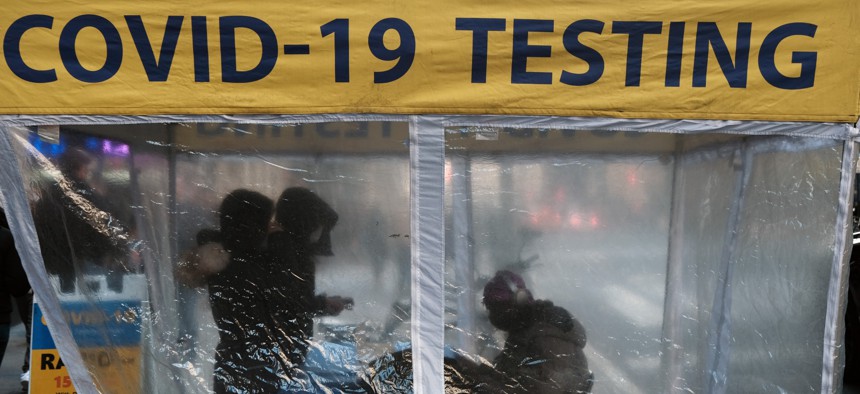
A COVID-19 testing site stands on a sidewalk in Midtown Manhattan on December 09 Spencer Platt/Getty Images
Holiday Activity Likely Caused a Spike in COVID-19 Infections
Travel and gatherings during Thanksgiving, plus the possible lack of at-home tests, may be responsible for a large increase in COVID-19 infections, according to a public-health researcher.
Death and COVID-19 infection rates climbed two weeks ago compared to three weeks ago, but still remained lower than December 2021 rates. Experts suggest holiday travel and a shortage of home tests could have contributed to the spike.
Infections
Rural counties reported 54,158 new infections two weeks ago, a 48% increase from three weeks ago. The rate of infections was 117.57 new cases per 100,000 residents.
There were 394,078 new infections last week in metropolitan areas, a 53% increase from the previous week. The rate of infection was 139.66 new cases per 100,000 residents in urban counties. Nationwide, there were 153,658 more new cases two weeks ago compared to three weeks ago.
Until last week’s report, urban and rural infection rates remained below 100 cases per 100,000 for the past several weeks. The last time infection rates reached 100 was the week of September 21st, when the rural infection rate was 102.84 and the urban rate was 100.98 per 100,000.
“I think [the increase in infection rates] can be directly tied to the Thanksgiving holiday period,” said Karl Minges, Ph.D., chair of the Department of Population Health and Leadership at the University of New Haven. “We had a record number of people traveling and the infections definitely increased as a result.”
Minges said that increased infection rates could also be caused by a more infectious strain of the Omicron variant, or by a shortage in home tests.
“Individuals could be going to local health departments and testing locations to get the test in light of not having access to the at-home test,” Minges said in a phone interview.
Because the CDC does not track infections detected through home testing, an increase in tests performed at health departments and doctors offices would increase the number of reported infections.
Deaths
Although infection rates were lower in rural areas, nonmetropolitan counties still took the lead in weekly death rates, surpassing urban rates by 80%. The number of Covid-19-related deaths more than doubled in rural America two weeks ago, from 278 three weeks ago to 584 two weeks ago. The weekly death rate was 1.27 deaths per 100,000 rural residents, 306 more deaths than the previous week.
The death rate in metropolitan counties was .83 deaths per 100,000, a 61% increase from two weeks ago. Urban deaths totaled 2,352 two weeks ago.
Compared to this time last year, however, death rates have improved. During the week of December 12th, 2021, the rural death rate was 4.55 deaths per 100,000 residents. That’s 72% higher than the rural death rate from two weeks ago.
The cumulative death rate in rural America was 409.59 deaths per 100,000 residents, 37% higher than the the urban cumulative death rate of 298.88 deaths per 100,000.
This article first appeared on The Daily Yonder and is republished here under a Creative Commons license.
![]()






